Dravidian peoples
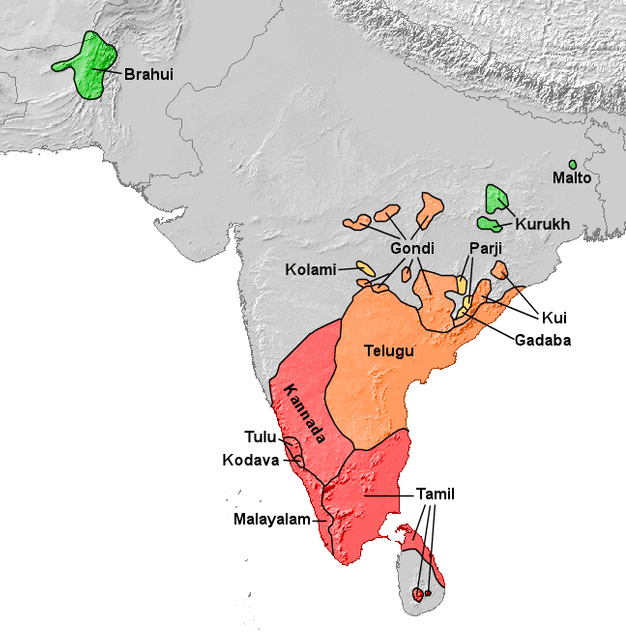
Dravidian peoples

| Dravidian | |
|---|---|
| Geographic distribution | South Asia and parts of Southeast Asia, mainly South India and Sri Lanka |
| Linguistic classification | One of the world's primary language families |
| Proto-language | Proto-Dravidian |
| Subdivisions |
|
| ISO 639-2 / 5 | dra |
| Linguasphere | 49= (phylozone) |
| Glottolog | drav1251 [149][4] |
| Total population | |
| approx. 245 million | |
| Languages | |
| Dravidian languages | |
| Religion | |
| Predominantly Hinduism, Dravidian folk religion and others: Jainism, Buddhism, Islam, Christianity, Judaism | |
Dravidian people or Dravidians are speakers of any of the Dravidian languages. There are around 245 million native speakers of Dravidian languages.[5] Dravidian speakers form the majority of the population of South India and are natively found in India, Pakistan, Afghanistan[6], Bangladesh, the Maldives and Sri Lanka.[7]
Proto-Dravidian may have been spoken in the Indus civilization, suggesting a "tentative date of Proto-Dravidian around the early part of the third millennium",[8] after which it branched into various Dravidian languages.[9] South Dravidian I (including pre-Tamil) and South Dravidian II (including pre-Telugu) split around the eleventh century BCE, with the other major branches splitting off at around the same time.[10]
The origins of the Dravidians are a "very complex subject of research and debate".[11] They may have been indigenous to the Indian subcontinent,[12][13][14] but origins in, or influence from, West-Asia have also been proposed.[15][16][17][18][19] Their origins are often viewed as being connected with the Indus Valley Civilisation,[11][19][20] whence people and language spread east- and southwards after the demise of the Indus Valley Civilisation in the early second millenium BCE,[21][22] concurrently with the arrival of Indo-Aryan speakers,[23] with whom they intensively interacted.[24] Some recent DNA evidence indicates a linkage between a corpse found in the Harappan site of Rakhigarhi in Haryana and "Ancestral South Indians".[25] From these interactions and migrations arose eventually the so-called "Hindus synthesis", after 500 BCE.[26]
The third century BCE onwards saw the development of large kingdoms in South India. Medieval Tamil guilds and trading organisations like the "Ayyavole and Manigramam" played an important role in the Southeast Asia trade.[27] and the cultural Indianisation of the region.
Dravidian visual art is dominated by stylised temple architecture in major centres, and the production of images of stone and bronze sculptures. The sculpture dating from the Chola period has become notable as a symbol of Hinduism.
| Dravidian | |
|---|---|
| Geographic distribution | South Asia and parts of Southeast Asia, mainly South India and Sri Lanka |
| Linguistic classification | One of the world's primary language families |
| Proto-language | Proto-Dravidian |
| Subdivisions |
|
| ISO 639-2 / 5 | dra |
| Linguasphere | 49= (phylozone) |
| Glottolog | drav1251 [149][4] |
| Total population | |
| approx. 245 million | |
| Languages | |
| Dravidian languages | |
| Religion | |
| Predominantly Hinduism, Dravidian folk religion and others: Jainism, Buddhism, Islam, Christianity, Judaism | |
Etymology
The origin of the Sanskrit word drāviḍa is tamiẓ ("Tamil").[28] In Prakrit, words such as "Damela", "Dameda", "Dhamila" and "Damila", which later evolved from "Tamila", could have been used to denote an ethnic identity.[29] In the Sanskrit tradition the word drāviḍa was also used to denote the geographical region of South India.[30] Epigraphic evidence of an ethnic group termed as such is found in ancient India where a number of inscriptions have come to light datable from the 6th to the 5th century BCE mentioning Damela or Dameda persons. The Hathigumpha inscription of the Kalinga ruler Kharavela refers to a T(ra)mira samghata (Confederacy of Tamil rulers) dated to 150 BCE. It also mentions that the league of Tamil kingdoms had been in existence for 113 years by that time.[31] In Amaravati in present-day Andhra Pradesh there is an inscription referring to a Dhamila-vaniya (Tamil trader) datable to the 3rd century CE.[31] Another inscription of about the same time in Nagarjunakonda seems to refer to a Damila. A third inscription in Kanheri Caves refers to a Dhamila-gharini (Tamil house-holder). In the Buddhist Jataka story known as Akiti Jataka there is a mention to Damila-rattha (Tamil dynasty).
Thamizhar is etymologically related to Tamil, the language spoken by Tamil people. Southworth suggests that the name comes from tam-miz > tam-iz 'self-speak', or 'one's own speech'.[32] Zvelebil suggests an etymology of tam-iz, with tam meaning "self" or "one's self", and -iz having the connotation of "unfolding sound". Alternatively, he suggests a derivation of tamiz < tam-iz < *tav-iz < *tak-iz, meaning in origin "the proper process (of speaking)".[33] The term Thamizhar was likely derived from the name of the ancient people Tamilar > Tamila > Damila > Dramila > Dravida.[34]
While the English word Dravidian was first employed by Robert Caldwell in his book of comparative Dravidian grammar based on the usage of the Sanskrit word drāviḍa in the work Tantravārttika by Kumārila Bhaṭṭa,[30] the word drāviḍa in Sanskrit has been historically used to denote geographical regions of Southern India as whole. Some theories concern the direction of derivation between tamiẓ and drāviḍa; such linguists as Zvelebil assert that the direction is from tamiẓ to drāviḍa.[35] The modern word Dravidian is devoid of any ethnic significance, and is only used to classify a linguistic family of the referred group.[29]
Ethnic groups
The largest-Dravidian ethnic groups are the Telugus from Andhra Pradesh and Telangana, the Tamils from Tamil Nadu, Sri Lanka, Malaysia and Singapore, the Kannadigas from Karnataka, the Malayalis from Kerala, and the Tulu people from Karnataka. Certain communities of Marathis from Maharashtra are considered as Scytho-Dravidians.[36][37]
| Name | Subgroup | Population | Notes |
|---|---|---|---|
| Badagas | South Dravidian | 133,500 (2011 census) | Badagas are found in Tamil nadu. |
| Brahuis | North Dravidian | 2.5 million | Brahuis are mostly found in the Balochistan region of Pakistan, with smaller numbers in southwestern Afghanistan. |
| Chenchus | South-Central Dravidian | N/A | Chenchus are found in Andra Pradesh, Telengana, and Odisha. |
| Irula | South Dravidian | 203,382 (2011 census) | Irula are found in Tamil nadu. |
| Giraavaru people | South Dravidian | 0 < 100 (Extinct) | Giraavaru people were found in Maldives. |
| Gondis | Central Dravidian | 13 million (approx.) | Gondi belong to the central Dravidian subgroup. They are spread over the states of Madhya Pradesh, Maharashtra, Chhattisgarh, Uttar Pradesh, Telangana, Andhra Pradesh, Bihar and Odisha. A state named Gondwana was proposed to represent them in India. |
| Khonds | South-Central Dravidian | 1,627,486 (2011 census) | Khonds are found in Odisha. |
| Kannadigas | South Dravidian | 43.7 million[38] | Kannadigas are native to Karnataka in India but considerable population is also found in Maharashtra, Tamil Nadu, Andhra Pradesh, Telangana and Kerala. |
| Kodavas | South Dravidian | 160,000(approx.) | Kodavas are native to Kodagu district. |
| Kurukh | North Dravidian | 3.6 million (approx.)[39] | Kurukh are spread over the states of Chhatishgarh, Jharkhand and Odisha. |
| Kurumbar | South Dravidian | N/A | Kurumbar are found in Tamil Nadu, Karnataka and Andhra Pradesh. |
| Malayalis | South Dravidian | 32.2 million[38] | Malayalis are native to Kerala and Lakshadweep, but are also found in Puducherry and parts of Tamil Nadu. They are also found in large numbers in Middle East countries, the Americas and Australia. |
| Paniya | South Dravidian | N/A | Paniya are found in Kerala and Tamil Nadu. |
| Tamils | South Dravidian | 78 million[40] | Tamils are native to Tamil Nadu, Puducherry and northern and eastern Sri Lanka, but are also found in parts of Kerala, Karnataka and Andhra Pradesh, although they have a large diaspora and are also widespread throughout many countries including South Africa, Singapore, the United States of America, Canada, Fiji, Indonesia, Vietnam, Cambodia, Philippines, Mauritius, European countries, Guyana, Suriname, French Guiana and Malaysia, as are the other three major Dravidian languages.[41] |
| Telugus | Central Dravidian | 85.1 million[42] | Telugus are native to Andhra Pradesh, Telangana and Yanam (Puducherry), but are also found in parts of Tamil Nadu, Karnataka, Orissa and Maharashtra. Further, they have a large diaspora and are also widespread throughout many countries including the United States of America, Canada, Australia and European countries. Telugu is the fastest growing language in the United States of America[43] |
| Todas | South Dravidian | 2,002 (2011 census) | Todas are found in Tamil Nadu. |
| Tuluvas | South Dravidian | 2 million (approx.) | Tuluvas are found in coastal Karnataka in India. A state named Tulu Nadu was proposed to represent them in India. |
Language
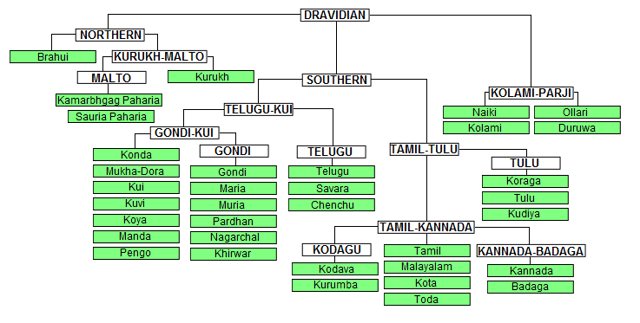
Dravidian language tree
The most commonly spoken Dravidian languages are Telugu (తెలుగు), Tamil (தமிழ்), Kannada (ಕನ್ನಡ), Malayalam (മലയാളം), Brahui (براہوئی), Tulu (ತುಳು), Gondi and Coorg. There are three subgroups within the Dravidian language family: North Dravidian, Central Dravidian, and South Dravidian, matching for the most part the corresponding regions in the Indian subcontinent.
Dravidian grammatical impact on the structure and syntax of Indo-Aryan languages is considered far greater than the Indo-Aryan grammatical impact on Dravidian. Some linguists explain this anomaly by arguing that Middle Indo-Aryan and New Indo-Aryan were built on a Dravidian substratum.[44] There are also hundreds of Dravidian loanwords in Indo-Aryan languages, and vice versa.
According to David McAlpin and his Elamo-Dravidian hypothesis, the Dravidian languages were brought to India by immigration into India from Elam, located in present-day southwestern Iran.[16][45] In the 1990s, Renfrew and Cavalli-Sforza have also argued that Proto-Dravidian was brought to India by farmers from the Iranian part of the Fertile Crescent,[15][46][47][1] but more recently Heggerty and Renfrew noted that "McAlpin's analysis of the language data, and thus his claims, remain far from orthodoxy", adding that Fuller finds no relation of Dravidian language with other languages, and thus assumes it to be native to India.[48] Renfrew and Bahn conclude that several scenarios are compatible with the data, and that "the linguistic jury is still very much out."[48]
As a proto-language, the Proto-Dravidian language is not itself attested in the historical record. Its modern conception is based solely on reconstruction. It is suggested that the language was spoken in the 4th millennium BCE, and started disintegrating into various branches around 3rd millennium BCE.[9] According to Krishnamurti, Proto-Dravidian may have been spoken in the Indus civilization, suggesting a "tentative date of Proto-Dravidian around the early part of the third millennium."[8] Krishnamurti further states that South Dravidian I (including pre-Tamil) and South Dravidian II (including pre-Telugu) split around the eleventh century BCE, with the other major branches splitting off at around the same time.[10]
History
Origins
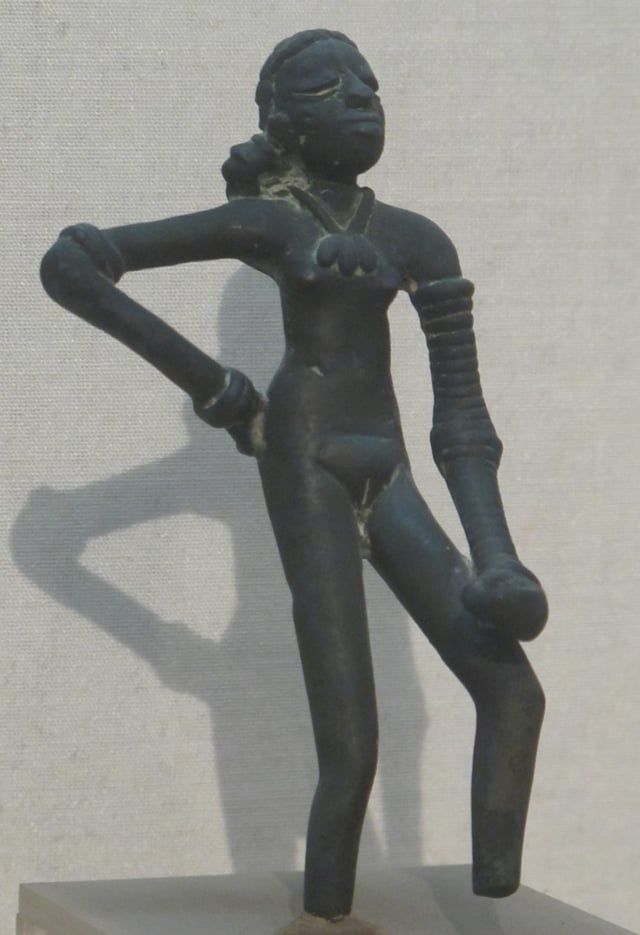
The Dancing Girl, a prehistoric bronze sculpture made in approximately 2500 BCE in the Indus Valley Civilisation city of Mohenjo-daro.
The origins of the Dravidians are a "very complex subject of research and debate." [11] They may have been indigenous to the Indian subcontinent,[49][13][14] but origins in, or influence from, West-Asia have also been proposed.[15][16][17][18][19] According to Narasimhan et al. (2018), Dravidians formed as a mixture of Archaic Ancestral South Asians, and Neolithic West Asian farmers from Iran.[50] Carleton S. Coon, in his book The Races of Europe (1939), classified the Dravidians as Caucasoid due to their "Caucasoid skull structure" and other physical traits such as noses, eyes and hair.[51]
Although in modern times speakers of various Dravidian languages have mainly occupied the southern portion of India, Dravidian speakers must have been widespread throughout the Indian subcontinent before the Indo-Aryan migration into the subcontinent.[24] According to Carole Davies, "many academic researchers have attempted to connect the Dravidians with the remnants of the great Indus Valley Civilisation, located in Northwestern India,"[11] most noteworthy Asko Parpola,[19] who did extensive research on the IVC-scripts.[19][20] The Brahui population of Balochistan in Pakistan has been taken by some as the linguistic equivalent of a relict population, perhaps indicating that Dravidian languages were formerly much more widespread and were supplanted by the incoming Indo-Aryan languages.[52] Nowadays Tamils, Malayalis, Telugus, Kannadigas that make up around 20% of India's population.[53]
Ancestors
Ancestral components
Reich et al. (2009) discerned two major ancestral components in India,[54][55][56] namely the Ancestral North Indians (ANI) who are "genetically close to Middle Easterners, Central Asians, and Europeans," and the Ancestral South Indians (ASI) which are clearly distinct from ANI[54] and "not closely related to groups outside the subcontinent."[57] Basu et al. (2016), discerned two additional components, Ancestral Tibeto-Burmese (ATB) and Ancestral Austro-Asiatic (AAA), noting that the ASI and the AAA were early settlers of India who differentiated after their arrival in India.[58][2] The ANI and ASI mixed in India between 4,200 and 1,900 years ago (2200 BCE-100 CE), whereafter a shift to endogamy took place,[56] possibly by the enforcement of "social values and norms" by the "Hindu Gupta rulers."[60] Northern Indians and higher castes are more related to West Eurasians, while southern Indians and lower castes are less related to West Eurasians.[61]
According to a large craniometric study (Raghavan and Bulbeck et al. 2013) the native populations of South Asia (India and Sri Lanka) have distinct craniometric and anthropologic ancestry. Both southern and northern groups are most similar to each other and have generally closer affinities to various "Caucasoid" groups. The study further showed that the native South Asians (including the Vedda) form a distinct group and are not related to the "Australoid" group.[62]
If there were an Australoid “substratum” component to Indians’ ancestry, we would expect some degree of craniometric similarity between Howells’ Southwest Pacific series and Indians. But in fact, the Southwest Pacific and Indian are craniometrically very distinct, falsifying any claim for an Australoid substratum in India.— Pathmanathan Raghavan, David Bulbeck, Gayathiri Pathmanathan and Suresh Kanta Rathee, Indian Craniometric Variability and Affinities (2013)
Formation of ASI
Moorjani et al. (2013) describe three scenarios regarding the bringing together of the two groups:
migrations before the development of agriculture (8,000–9,000 years before present (BP));
migration of western Asian people together with the spread of agriculture, maybe up to 4,600 years BP;
migrations of western Eurasians from 3,000 to 4,000 years BP.[63]
According to Gallego Romero et al. (2011), their research on lactose tolerance in India suggests that "the west Eurasian genetic contribution identified by Reich et al. (2009) principally reflects gene flow from Iran and the Middle East."[64] Gallego Romero notes that Indians who are lactose-tolerant show a genetic pattern regarding this tolerance which is "characteristic of the common European mutation."[65] According to Romero, this suggests that "the most common lactose tolerance mutation made a two-way migration out of the Middle East less than 10,000 years ago. While the mutation spread across Europe, another explorer must have brought the mutation eastward to India – likely traveling along the coast of the Persian Gulf where other pockets of the same mutation have been found."[65]
Asko Parpola, who regards the Harappans to have been Dravidian, notes that Mehrgarh (7000 BCE to c. 2500 BCE), to the west of the Indus River valley,[66] is a precursor of the Indus Valley Civilisation, whose inhabitants migrated into the Indus Valley and became the Indus Valley Civilisation.[18] It is one of the earliest sites with evidence of farming and herding in South Asia.[67][68] According to Lukacs and Hemphill, while there is a strong continuity between the neolithic and chalcolithic (Copper Age) cultures of Mehrgarh, dental evidence shows that the chalcolithic population did not descend from the neolithic population of Mehrgarh,[69] which "suggests moderate levels of gene flow."[69] They further noted that "the direct lineal descendants of the Neolithic inhabitants of Mehrgarh are to be found to the south and the east of Mehrgarh, in northwestern India and the western edge of the Deccan plateau," with neolithic Mehrgarh showing greater affinity with chalocolithic Inamgaon, south of Mehrgarh, than with chalcolithic Mehrgarh.[69]
Narasimhan et al. (2018) conclude that ANI and ASI were formed in the 2nd millennium BCE.[21] They were preceded by a mixture of AASI (ancient ancestral south Indians, that is, hunter-gatherers), and Iranian agri-culturalists who arrived in India at ca. 4700-3000 BCE, and "must have reached the Indus Valley by the 4th millennium BCE."[21] According to Narasimhan et al., this population, which probably was native to the Indus Valley Civilisation, "contributed in large proportions to both the ANI and ASI," which took shape during the 2nd millennium BCE. ANI formed out of a mixture of "Indus_Periphery-related groups" and migrants from the steppe, while ASI was formed out of "Indus_Periphery-related groups" who moved south and mixed with hunter-gatherers.[21]
Indus Valley Civilization
Dravidian identification
The Indus Valley civilization (2,600-1,900 BCE) located in the northwest of the Indian subcontinent is sometimes identified as having been Dravidian.[70] Already in 1924, when announcing the discovery of the IVC, John Marshall stated that (one of) the language(s) may have been Dravidic.[71] Cultural and linguistic similarities have been cited by researchers Henry Heras, Kamil Zvelebil, Asko Parpola and Iravatham Mahadevan as being strong evidence for a proto-Dravidian origin of the ancient Indus Valley civilisation.[72][73] The discovery in Tamil Nadu of a late Neolithic (early 2nd millennium BCE, i.e. post-dating Harappan decline) stone celt allegedly marked with Indus signs has been considered by some to be significant for the Dravidian identification.[74][75]
Yuri Knorozov surmised that the symbols represent a logosyllabic script and suggested, based on computer analysis, an underlying agglutinative Dravidian language as the most likely candidate for the underlying language.[76] Knorozov's suggestion was preceded by the work of Henry Heras, who suggested several readings of signs based on a proto-Dravidian assumption.[77]
Linguist Asko Parpola writes that the Indus script and Harappan language are "most likely to have belonged to the Dravidian family".[78] Parpola led a Finnish team in investigating the inscriptions using computer analysis. Based on a proto-Dravidian assumption, they proposed readings of many signs, some agreeing with the suggested readings of Heras and Knorozov (such as equating the "fish" sign with the Dravidian word for fish, "min") but disagreeing on several other readings. A comprehensive description of Parpola's work until 1994 is given in his book Deciphering the Indus Script.[79]
Decline, migration and Dravidianization
Paleoclimatologists believe the fall of the Indus Valley Civilisation and eastward migration during the late Harappan period was due to climate change in the region, with a 200-year long drought being the major factor.[80][22][81] The Indus Valley Civilisation seemed to slowly lose their urban cohesion, and their cities were gradually abandoned during the late Harappan period, followed by eastward migrations before the Indo-Aryan migration into the Indian subcontinent.[22]
The process of post-Harappan/Dravidian influences on southern India has tentatively been called "Dravidianization",[23] and is reflected in the post-Harappan mixture of IVC and Ancient Ancestral South Indian people.[82] Yet, according to Krishnamurti, Dravidian languages may have reached south India already before the Indo-Aryan migrations.[83]
Dravidian and Indo-Aryan interactions
Dravidian substrate
The Dravidian language influenced the Indo-Aryan languages. Dravidian languages show extensive lexical (vocabulary) borrowing, but only a few traits of structural (either phonological or grammatical) borrowing from Indo-Aryan, whereas Indo-Aryan shows more structural than lexical borrowings from the Dravidian languages.[24] Many of these features are already present in the oldest known Indo-Aryan language, the language of the Rigveda (c. 1500 BCE), which also includes over a dozen words borrowed from Dravidian. The linguistic evidence for Dravidian impact grows increasingly strong as we move from the Samhitas down through the later Vedic works and into the classical post-Vedic literature.[84] This represents an early religious and cultural fusion[26][3] or synthesis[86] between ancient Dravidians and Indo-Aryans.[87][85][88][89]
According to Mallory there are an estimated thirty to forty Dravidian loanwords in Rig Veda.[90] Some of those for which Dravidian etymologies are certain include ಕುಲಾಯ kulāya "nest", ಕುಲ್ಫ kulpha "ankle", ದಂಡ daṇḍa "stick", ಕುಲ kūla "slope", ಬಿಲ bila "hollow", ಖಲ khala "threshing floor".[91] [] [91] While J. Bloch and M. Witzel believe that the Indo-Aryans moved into an already Dravidian speaking area after the oldest parts of the Rig Veda were already composed.[92]
According to Thomason and Kaufman, there is strong evidence that Dravidian influenced Indic through "shift", that is, native Dravidian speakers learning and adopting Indic languages.[93] According to Erdosy, the most plausible explanation for the presence of Dravidian structural features in Old Indo-Aryan is that the majority of early Old Indo-Aryan speakers had a Dravidian mother tongue which they gradually abandoned.Erdosy (1995:18) Even though the innovative traits in Indic could be explained by multiple internal explanations, early Dravidian influence is the only explanation that can account for all of the innovations at once. Early Dravidian influence accounts for several of the innovative traits in Indic better than any internal explanation that has been proposed.[94] According to Zvelebil, "several scholars have demonstrated that pre-Indo-Aryan and pre-Dravidian bilingualism in India provided conditions for the far-reaching influence of Dravidian on the Indo-Aryan tongues in the spheres of phonology, syntax and vocabulary."[95]
Sanskritization
With the rise of the Kuru Kingdom a process of Sanskritization started which influenced all of India, with the populations of the north of the Indian subcontinent predominantly speaking the Indo-Aryan languages.[96]
Dravidian empires
The third century BCE onwards saw the development of large Dravidian empires like Chera, Chola, Pandyan, Rashtrakuta, Satavahana, Vijayanagara, Pallava, Chalukya, Hoysala, Kingdom of Mysore , Nizam of Hyderabad and smaller kingdoms like Ay, Alupa, Western Ganga, Eastern Ganga, Kadamba, Kalabhra, Andhra Ikshvaku, Vishnukundina, Western Chalukya, Eastern Chalukya, Sena, Kakatiya, Reddy, Mysore, Jaffna, Travancore, Venad, Cochin, Cannanore, Calicut and the Nayakas.
Medieval trade and influence
Medieval Tamil guilds and trading organisations like the "Ayyavole and Manigramam" played an important role in the southeast Asia trade.[27] Traders and religious leaders travelled to southeast Asia and played an important role in the cultural Indianisation of the region. Locally developed scripts such as Grantha and Pallava script induced the development of many native scripts such as Khmer, Javanese Kawi script, Baybayin, and Thai.
Dravidian culture
Religious belief
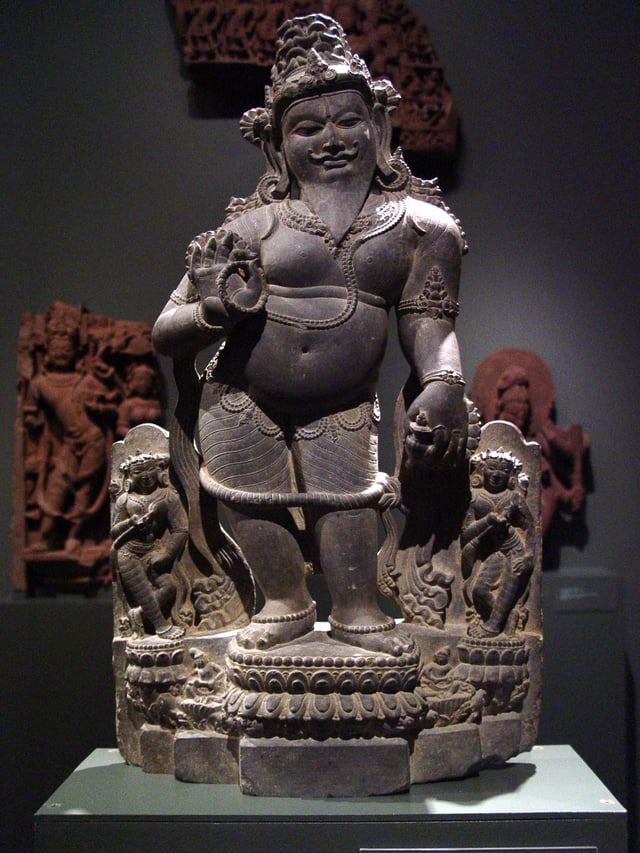
Sage Agastya, father of Tamil literature
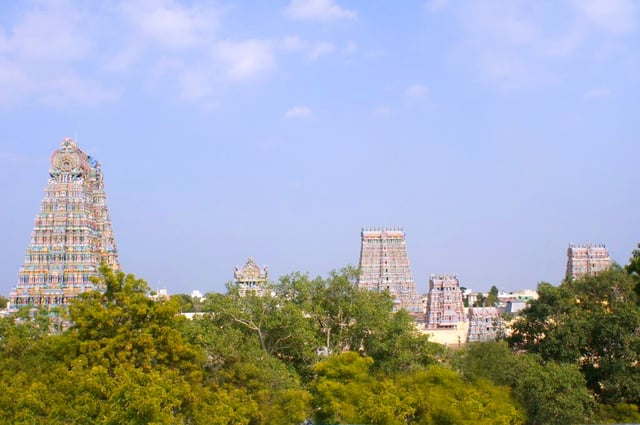
Meenakshi Amman temple, dedicated to Goddess Meenakshi, tutelary deity of Madurai city
Ancient Dravidian religion constituted of a animistic and non-Vedic form of religion which may have influenced the Āgamas, Vedic and non-Vedic texts[97] which post-date the Vedic texts.[98] The Agamas are Tamil and Sanskrit scriptures chiefly constituting the methods of temple construction and creation of murti, worship means of deities, philosophical doctrines, meditative practices, attainment of sixfold desires and four kinds of yoga.[99] The worship of tutelary deities, sacred flora and fauna in Hinduism is recognized as a survival of the pre-Vedic Dravidian religion.[100] Hinduism can be regarded as a religious and cultural fusion[26][3] or synthesis[86] between ancient Dravidians and Indo-Aryans, and other local elements.[87][85][88][89]
Ancient Tamil grammatical works Tolkappiyam, the ten anthologies Pattuppāṭṭu, and the eight anthologies Eṭṭuttokai shed light on early ancient Dravidian religion. Seyyon was glorified as the red god seated on the blue peacock, who is ever young and resplendent, as the favored god of the Tamils.[101] Sivan was also seen as the supreme God.[101] Early iconography of Seyyon[102] and Sivan[103][104][105] and their association with native flora and fauna goes back to the Indus Valley Civilisation.[106][107] The Sangam landscape was classified into five categories, thinais, based on the mood, the season and the land. Tolkappiyam mentions that each of these thinai had an associated deity such as Seyyon in Kurinji-the hills, Thirumaal in Mullai-the forests, and Kotravai in Marutham-the plains, and Wanji-ko in the Neithal-the coasts and the seas. Other gods mentioned were Mayyon and Vaali who are all major deities in Hinduism today. This represents an early religious and cultural fusion[26][3] or synthesis[86] between ancient Dravidians and Indo-Aryans, which became more evident over time with sacred iconography, traditions, philosophy, flora and fauna that went on to influence and shape Indian civilisation.[87][85][88][89]
Throughout Tamilakam, a king was considered to be divine by nature and possessed religious significance.[108] The king was 'the representative of God on earth' and lived in a "koyil", which means the "residence of a god". The Modern Tamil word for temple is koil (Tamil: கோயில்). Ritual worship was also given to kings.[109][110] Modern words for god like "kō" (Tamil: கோ "king"), "iṟai" (இறை "emperor") and "āṇḍavar" (ஆண்டவன் "conqueror") now primarily refer to gods. These elements were incorporated later into Hinduism like the legendary marriage of Shiva to Queen Mīnātchi who ruled Madurai or Wanji-ko, a god who later merged into Indra.[111] Tolkappiyar refers to the Three Crowned Kings as the "Three Glorified by Heaven", (Tamil: வாண்புகழ் மூவர், Vāṉpukaḻ Mūvar ?).[112] In the Dravidian-speaking South, the concept of divine kingship led to the assumption of major roles by state and temple.[113]
The cult of the mother goddess is treated as an indication of a society which venerated femininity. This mother goddess was conceived as a virgin, one who has given birth to all and one, and were typically associated with Shaktism.[114] The temples of the Sangam days, mainly of Madurai, seem to have had priestesses to the deity, which also appear predominantly a goddess.[115] In the Sangam literature, there is an elaborate description of the rites performed by the Kurava priestess in the shrine Palamutircholai.[116]
Among the early Dravidians the practice of erecting memorial stones "Natukal and Viragal’' had appeared, and it continued for quite a long time after the Sangam age, down to about the 16th century.[117] It was customary for people who sought victory in war to worship these hero stones to bless them with victory.[118]
Architecture and visual art
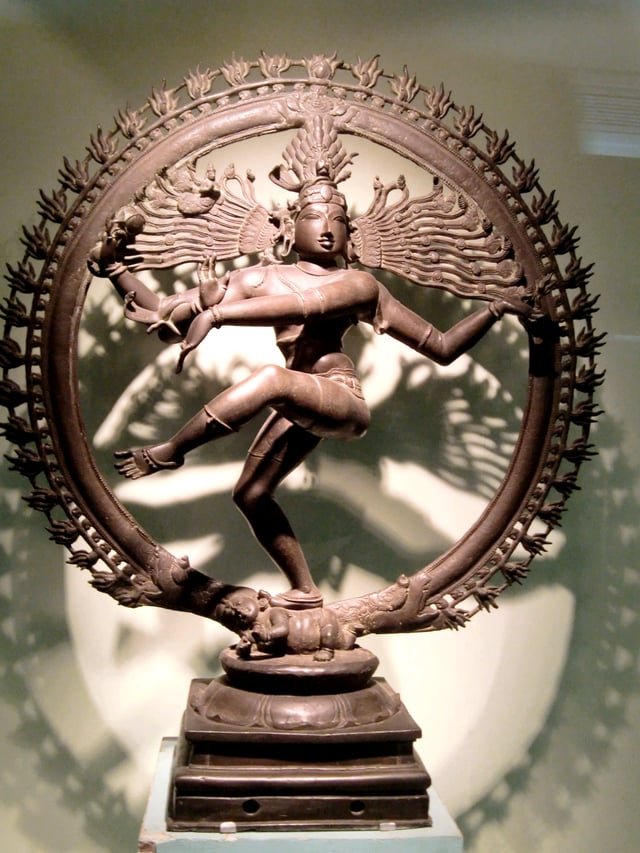
Nataraja, example of Chola Empire bronze has become notable as a symbol of Hinduism.

Typical layout of Dravidian temple architecture, 9th century A.D
Throughout Tamilakam, a king was considered to be divine by nature and possessed religious significance.[108] The king was 'the representative of God on earth’ and lived in a "koyil", which means the "residence of a god". The Modern Tamil word for temple is koil (Tamil: கோயில்). Titual worship was also given to kings.[109][110] Modern words for god like "kō" (Tamil: கோ "king"), "iṟai" (இறை "emperor") and "āṇḍavar" (ஆண்டவன் "conqueror") now primarily refer to gods.[111] Tolkappiyar refers to the Three Crowned Kings as the "Three Glorified by Heaven", (Tamil: வாண்புகழ் மூவர், Vāṉpukaḻ Mūvar ?).[112] In the Dravidian-speaking South, the concept of divine kingship led to the assumption of major roles by state and temple.[113]
Mayamata and Manasara shilpa texts estimated to be in circulation by the 5th to 7th century AD, are guidebooks on the Dravidian style of Vastu Shastra design, construction, sculpture and joinery technique.[119][120] Isanasivagurudeva paddhati is another text from the 9th century describing the art of building in India in south and central India.[119][121] In north India, Brihat-samhita by Varāhamihira is the widely cited ancient Sanskrit manual from the 6th century describing the design and construction of Nagara style of Hindu temples.[122][123][124] Traditional Dravidian architecture and symbolism are also based on Agamas. The Agamas are non-Vedic in origin[97] and have been dated either as post-Vedic texts [98] or as pre-Vedic compositions.[125] The Agamas are a collection of Tamil and Sanskrit scriptures chiefly constituting the methods of temple construction and creation of murti, worship means of deities, philosophical doctrines, meditative practices, attainment of sixfold desires and four kinds of yoga.[99]
Chola style temples consist almost invariably of the three following parts, arranged in differing manners, but differing in themselves only according to the age in which they were executed:[126]
The porches or Mantapas, which always cover and precede the door leading to the cell.
Gate-pyramids, Gopuras, which are the principal features in the quadrangular enclosures that surround the more notable temples. Gopuras are very common in Dravidian temples.
Pillared halls (Chaultris or Chawadis) are used for many purposes and are the invariable accompaniments of these temples.
Besides these, a south Indian temple usually has a tank called the Kalyani or Pushkarni – to be used for sacred purposes or the convenience of the priests – dwellings for all the grades of the priesthood are attached to it, and other buildings for state or convenience.[126]
Theatre, dance and music
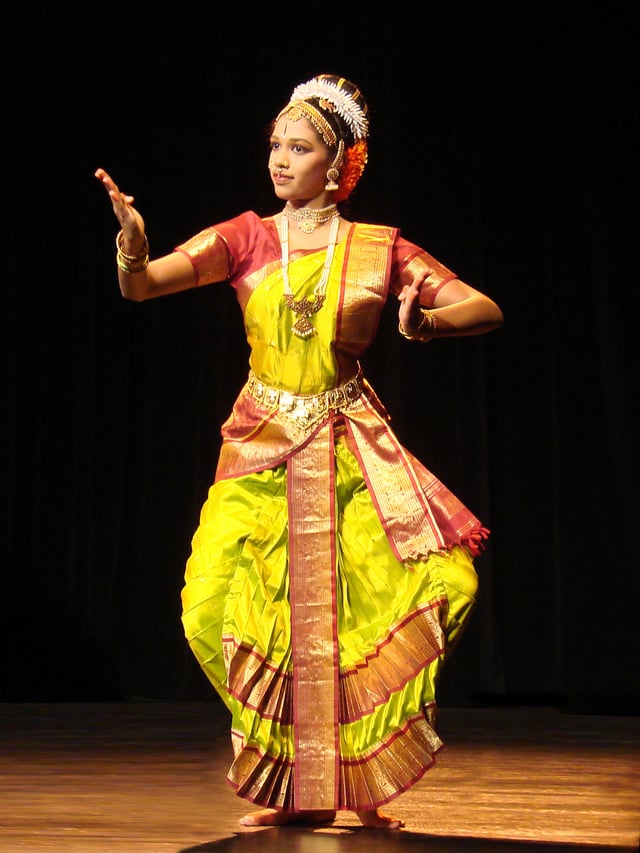
A Kuchipudi dancer.
Literary evidence of traditional form of theatre, dance and music dates back to the 3rd century BCE.[127] Ancient literary works, such as the Cilappatikaram, describe a system of music.[127] The theatrical culture flourished during the early Sangam age. Theatre-dance traditions have a long and varied history whose origins can be traced back almost two millennia to dance-theatre forms like Kotukotti, Kaapaalam and Pandarangam, which are mentioned in an ancient anthology of poems entitled the Kaliththokai.[128] Dance forms such as Bharatanatyam are based on older temple dance forms known as Catir Kacceri, as practised by courtesans and a class of women known as Devadasis.[129]
Carnatic music originated in the Dravidian region. With the growing influence of Persian and Sufi music on Indian music, a clear distinction in style appeared from the 12th century onwards. Many literary works were composed in Carnatic style and it soon spread wide in the Dravidian regions. The most notable Carnatic musician is Purandara Dasa who lived in the court of Krishnadevaraya of the Vijayanagara empire. He formulated the basic structure of Carnatic music and is regarded as the Pitamaha (lit, "father" or the "grandfather") of Carnatic Music. Kanakadasa is another notable Carnatic musician who was Purandaradasa's contemporary.
Costume
Dravidian speakers in Southern India wear varied traditional costumes depending on their region, largely influenced by local customs and traditions.
Martial arts and sports
In Mahabaratha was mentioned, that Bhishma claimed that Southerns are skilled with sword-fighting in general and Sahadeva was chosen for the conquest of the southern kingdoms, because of his swordsman skills.[131] In South India various types of martial arts are practiced like Kalaripayattu and Silambam. It is speculated that Bodhidarma was a sixth-century Pallava prince, who became a Buddhist monk, although the credibility of the same is debatable.[132]
In ancient times there were fights ankam, public duels to the death, to solve disputes between his opposing rules.[133] Among some communities, young girls received preliminary training up until the onset of menses.[133] In vadakkan pattukal ballads, at least a few women warriors continued to practice and achieved a high degree of expertise.[133]
Sports like Kambala, Jallikattu, Kabaddi, Vallam Kali, Lambs and Tigers, Maramadi are parts of Dravidian culture.
See also
- General
Dravidian languages
Dravidian University (dedicated to research and learning of Dravidian languages)
- Culture
Dance forms of Andhra Pradesh
Culture of Telangana
Arts of Kerala
Dance forms of Tamil Nadu
Folk arts of Karnataka
- Other
Indo-Aryan peoples